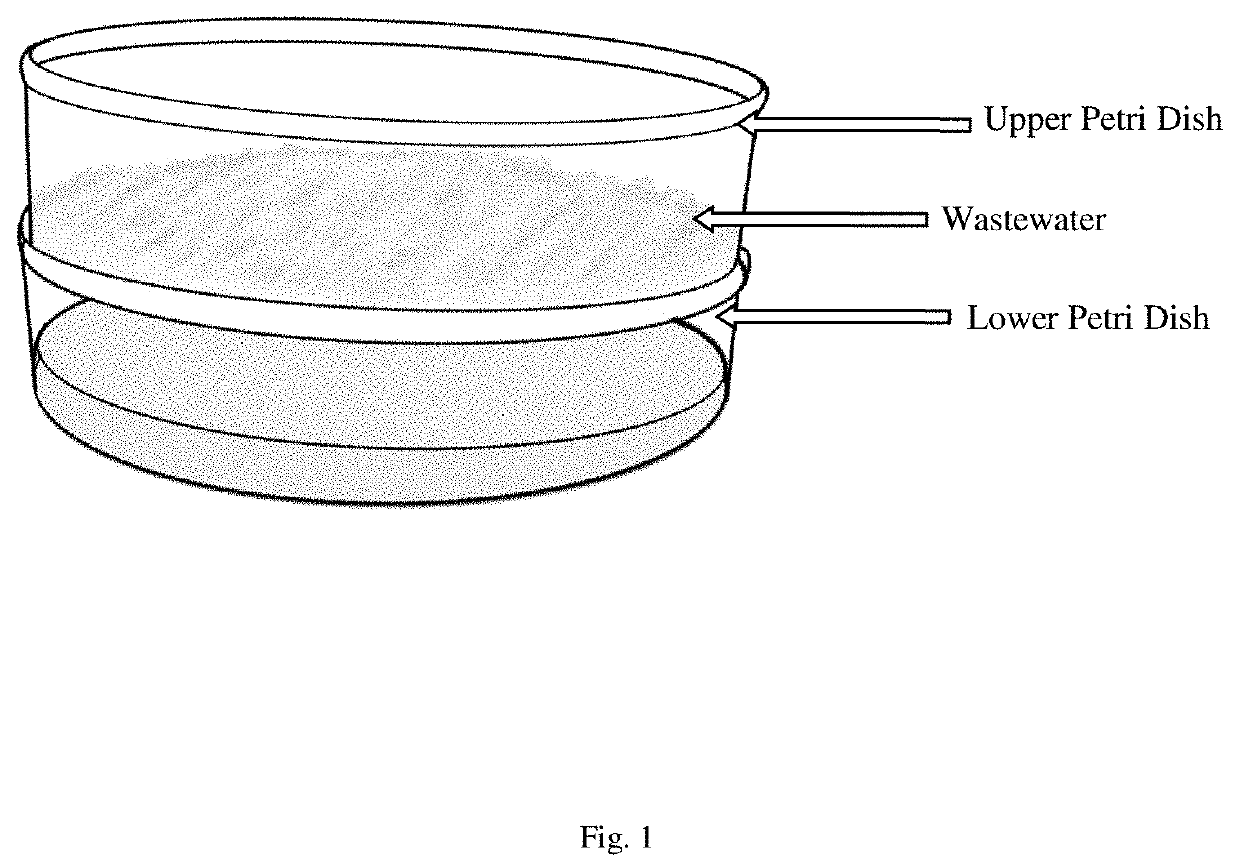New Device of Wastewater Treatment using Renewable Energy
a renewable energy and wastewater treatment technology, applied in water/sludge/sewage treatment, biochemistry equipment, biochemistry apparatus and processes, etc., can solve the problems of increasing the burden on wastewater treatment systems, further needs to be de-chlorinated, and fish may be toxic to chlorin
- Summary
- Abstract
- Description
- Claims
- Application Information
AI Technical Summary
Benefits of technology
Problems solved by technology
Method used
Image
Examples
embodiment 1
[0036]In a bench scale experiment, a device consists of two glass Petri dishes, fixed one over the second to make upper and lower plates. A volume of 60 ml of wastewater is put in the upper plate and 20 ml of distilled water in the lower plate. Place the device beside a window to be exposed to sunlight. On examination the lower surface of the upper plate after 30 minutes is cloudy and buildup of water droplets starts and is increased as time passes. Water droplets increase in size with time and allowed to fall freely on the lower plate and was measured by the increase of water volume of the lower plate. After 48 hours, water in the upper plate dried out leaving waste debris and the volume of water in lower plate increased by approximately 44 ml.
embodiment 2
[0037]Further, in another bench scale experiment, arrange a device to consist of three glass Petri dishes and fix one over the other to make upper, middle and lower plates. Put 60 ml wastewater in each of the upper and middle plates and 20 ml of distilled water in the lower plate. Place the device beside a window to be exposed to sunlight. On examination the lower surface of the upper and middle plates after 30 minutes are cloudy and buildup of water droplets starts and is increased as time passes. Collect water droplets from the upper and middle plates with sterile glass rod to measure its volume. The water volume is approximately double the volume obtained in step 4.
embodiment 3
[0038]In an outdoor experiment, use rounded plastic containers of same size and arrange as upper and lower plates. A volume of 400 ml wastewater is put in the upper plate and 100 ml of distilled water in the lower plate. Place the device outdoors to be exposed to direct sunlight and was inspected regularly. After 48 hours, wastewater in upper plate dried out leaving debris while in the lower container freshwater was about 400 ml at experiment termination.
[0039]Technical Description
[0040]In the present invention, we used SE in form of the entire electromagnetic spectrum that reach the earth surface as the sole source of energy. Making use of the fact that ordinary bulk water exists in two kinds: HDW and LDW prompted us to think of the present invention. For instance, in the upper container the positively-charged HDW lies in lower position and towards the container's upper side lies the negatively-charged LDW. The lower container contains distilled water with negatively-charged ions. ...
PUM
 Login to View More
Login to View More Abstract
Description
Claims
Application Information
 Login to View More
Login to View More - R&D
- Intellectual Property
- Life Sciences
- Materials
- Tech Scout
- Unparalleled Data Quality
- Higher Quality Content
- 60% Fewer Hallucinations
Browse by: Latest US Patents, China's latest patents, Technical Efficacy Thesaurus, Application Domain, Technology Topic, Popular Technical Reports.
© 2025 PatSnap. All rights reserved.Legal|Privacy policy|Modern Slavery Act Transparency Statement|Sitemap|About US| Contact US: help@patsnap.com


